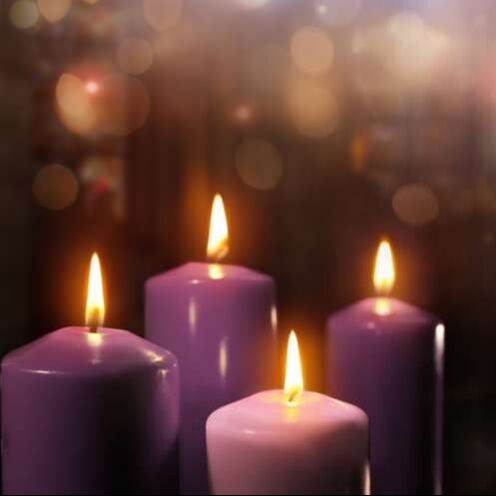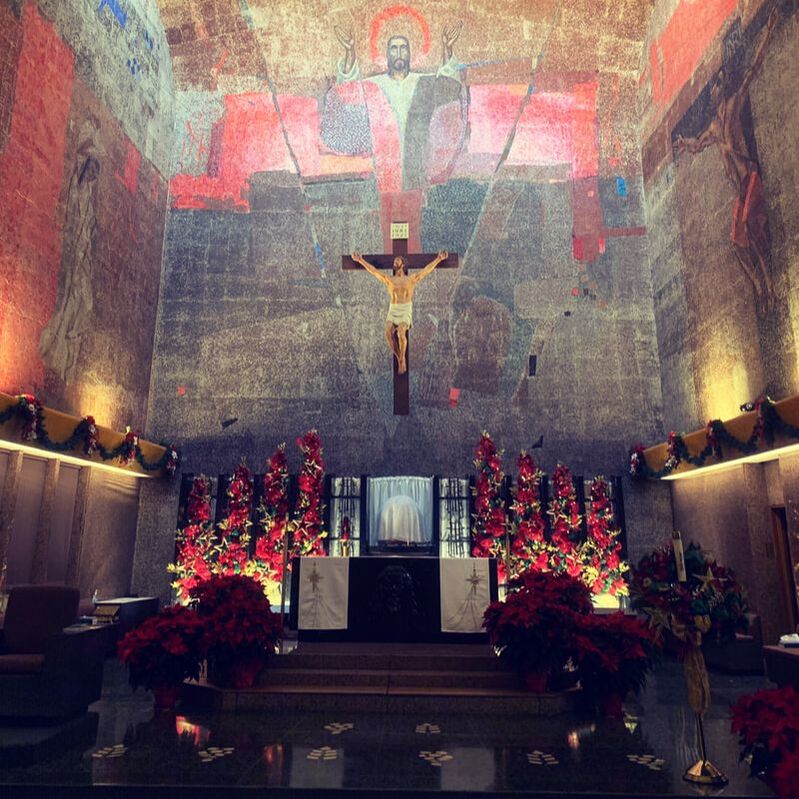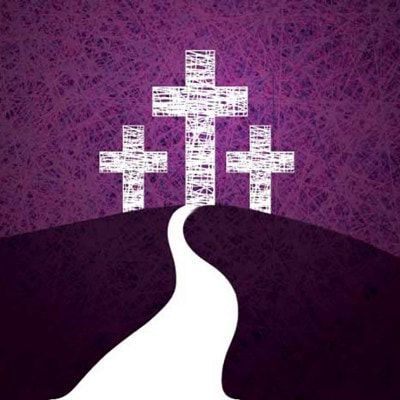Church Exterior
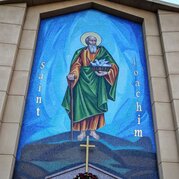
St. Joachim's 1000-seat church is 180 feet long, 47 feet high and 97 feet wide. It was designed by architect Kazuo Goto, A.I.A., of Berkeley and constructed by Robert G. Fisher Company, Inc., of Fresno. Madera's Rogers Materials Company delivered the 1,100 yards of concrete which went into the church building. The heating and air conditioning systems are housed in the bell tower which soars 135 feet into the sky with a clean, dramatic, stainless steel cross. Walls and tower are reinforced concrete; the roof is steel and wood.
Church interior |
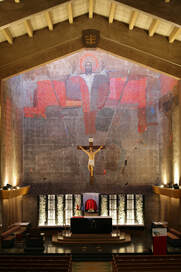
Christian symbols and art are to be found, not only in churches and holy places, but in every home and on street corners, on mountain tops and in the most forgotten places. They stand as witnesses to the Christian Faith of times past and of the present, of people's beliefs, loves and fears. They stand, even today, as signs and reminders of the hidden treasures of our Faith.
Family Chapel |
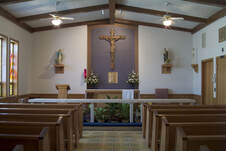
The Family Chapel is open every day of the week. From Monday - Friday there is Adoration of the Blessed Sacrament. It is available for Weddings, Memorial Masses and Quinceañeras on Saturday. Saturday evenings and Sundays it is used as overflow seating for Masses.
The Family Chapel is open every day of the week. From Monday - Friday there is Adoration of the Blessed Sacrament. It is available for Weddings, Memorial Masses and Quinceañeras on Saturday. Saturday evenings and Sundays it is used as overflow seating for Masses.
Sanctuary Religious Objects |

The Sanctuary is the heart of the church, the "Holy of Holies," the center of every liturgical celebration where the altar is located. It is set aside from the rest of the church structure and is reserved for the priests and the ministers directly involved in the liturgical service. In the Temple of Jerusalem the Sanctuary was separated from the main body of the Temple by a curtain which hung from the ceiling to the floor. Behind the curtain was situated the altar of sacrifice, the Ark of the Covenant, the staff of Aaron, and a jar of manna. Only the High Priest was allowed to enter. When Jesus died on the Cross, the curtain of the Temple "was torn from top to bottom" as all three synoptic Gospels point out. This symbolic occurrence has been interpreted by the Church to signify that the death of Jesus removed the veil of mystery separating God from men, thus allowing man to have free access to Him as to a father.
Statues: Monuments to the Heroes of our Faith |
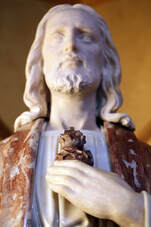
Although Moses' legislation in the Old Testament had forbidden the veneration of images so that the Israelites would not succumb to the worship of them in imitation of their pagan neighbors, the New Covenant abrogated this prohibition, and the Christians of the early centuries show no qualm of conscience in their veneration of images. The catacombs contain rude but devotional representations of Christ, the Cross, and the Saints. After the triumph of Christianity with the Edict of Constantine, more elaborate expressions of Christian piety appeared above ground in the new churches. Statues, icons, paintings, and other artistic representations of our Lord, the Virgin Mary, and the Saints have become an integral part of Catholic devotion, as much as keeping pictures of the members of our family and friends is an expression of how much we want to make them a part of our lives. A statue of a saint is a monument to a hero of our Catholic family. We do not worship it, as we do not worship the monuments to the heroes of our country. Like any other religious image, statues are placed in a church merely for the promotion of reverence and devotion.
Stained Glass windows |
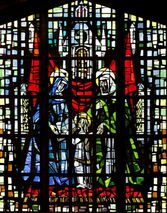
One of the most significant 20th Century contributions to the stained glass window's art was the development of "slab glass." Instead of being blown into sheets in the traditional manner, the glass is cast in panels which are then chipped and bound together with cement instead of lead. All the main stained glass windows of our church are made of one inch thick "slab glass," except the low windows of the "Beatitudes," and were designed and produced by Mr. Max Ingrand of Paris, France. For a true experience and appreciation of the beauty and breathtaking effects of a stained glass window, just stand below it as the rays of the sun stream though the multi-colored glass and bathe yourself in an awe inspiring cascade of light and colors!
Stations of the Cross |
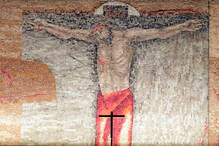
One of the more familiar exercises of Christian piety is the Stations of the Cross. As practiced today, the devotion centers on 14 meditations of the suffering of Christ on His way to Calvary and His death on the Cross. Each station is a halting place at which the faithful are moved to sorrowful contemplation. The devotion is practiced in imitation of the pilgrims who travel to the Holy Land during Holy Week to visit the places hallowed by Christ's final day of His life on earth. The idea of a series of shrines or images representing the places and events of the Passion became fairly general by the 15th Century. The thoughtful meditation of each station offers a deep, moving example of the way a person can die with dignity even under the most cruel circumstances of infamy and shame. In the center aisle Roman numerals on the terrazo floor mark the station's number. Start from the South East side. The mosaic artwork is by Alberto Garcia Alvarez, the mosaic itself was done by Fauret Mosaic Studios, Pietrasanta, Italy.
Mosaics |
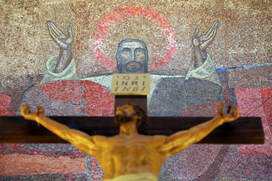
Commissioned to create a huge mosaic that would cover the walls of the whole sanctuary of St. Joachim's church, artist Alberto Garcia Alvarez from Mallorca, Spain, set out to depict the history of our Redemption. With bold, vivid, stark simplicity, God's intervention in the history of mankind is presented in its most dramatic moments and its most essential elements: The annunciation, the death of the Son of God made man, and His glorious resurrection and ascension into heaven. Victory over sin and death has been achieved! At first Mr. Garcia Alvarez wanted to represent the Resurrection of Christ also as the resurrection of all mankind. by adding to the figure of the Risen Christ five other figures symbolizing the souls who were released from Limbo by His death and resurrection. After due consideration, he decided to omit these five. "Since the altar is the most important spot on which the attention of the congregation should be direction, I believe we have to simplify the representation of the theme on the huge walls is Redemption, I think the resurrection of the dead does not have to be included in an explanation of the Redemption. The resurrection of the dead is a consequence and the final result of the Redemption but not the fact. If we have Christ only in resurrection, as High Priest offering His own sacrifice to the Father, then all attention comes to this central figure and to the altar just beneath it.
Decorations at St. Joachim According to liturgical Season
|
|

